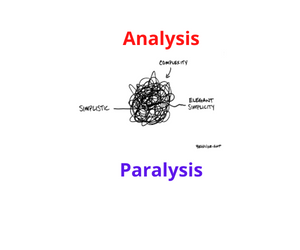“In all my years in this business, I have never known a time when we have had less money to spend on process improvement. All the money is going on regulatory, must-do stuff.” That is an excerpt from one of two recent conversations with senior Operations professionals that have inspired this week’s post.
Both are friends, both street smart, both have been through many up and down cycles in the Investment Banking business, both are in leading positions, both have been in the business 20 years or more, both have done their 10’000 hours.
From one of them, the view is that the only money they have to do any change is for things that one or other regulator has mandated that they do. He maligned the fact that in the past, there was enough flexibility to make some of the improvements that he thought were the right thing to do. Very much in the style advocated by the very successful US Chairman of the Joint Chiefs of Staff and later Secretary of State, Colin Powell, in his lessons on leadership (see number 16, Click Here); the commander in the field is right, the rear echelon wrong. Every last penny of that flexibility is gone.
Banks are notoriously simplistic when the markets turn down. They focus almost exclusively on the next quarter and what they think the analysts want to see. Very seldom do they exit whole business segments. So the folks on the infrastructure side of the business; IT, Ops, Financial Control and so on, will all ask the business side: “If you, the business, tell me what you are not going to do, what you are going to cut, I can work out how to reduce costs.” “Well actually, we want to do the same things, but less of them,” comes the reply. So there are going to be just as many systems to support, just as many settlement processes and the expectation is to do all of that with fewer people. In the end, the only option open to the managers is to make linear cuts and simply cut the required 10 or 20%.
From my other friend, I had a message of warning about the impact of making these linear cuts: “We are now cutting into the bone; we have so few experts that if one is on holiday and one is sick, we would not be able to deal with a major event like a Euro exit by one or other country.”
Now clearly any organisation needs a strategy and that is complemented by the tactics of day-to-day operations. In a bank, that translates to resources being allocated to two activities: these are commonly known as “Run The Bank (RTB)” and “Change The Bank (CTB)”. Change is normally divided up into two buckets: Mandatory and Discretionary. As of September 2012, Mandatory is 100%, or close to, of every bank’s budget. There is no money to spend on improving processes or doing what you know is the right thing to pre-empt the industry’s evolution.
Now ironically, one of my friends commented that whilst he has never known budgets so constricted, he has never seen such an all round front-to-back awareness of what needs to be done; but, there is still no spare money.
“The markets will come back!” This is an old battle cry when revenues are down. Those revenues have indeed bounced back time and again. My own sense is that banking has substantial over capacity and that longer-term we will see a few global banks and a number of strong regional niche players. Increasingly, it will be hard to earn what the economists call super-normal profits, or bankers might call “Goldman Sachs-like profits”. Inside banking, the FX business is already an example of this with very transparent, thin spreads. This is as close to the theoretical world of “perfect competition” taught in Economics (Click Here for more) as any market I have encountered.
If the revenue side is a given size, then it ought to be the case that the company with the best process wins, because that way you keep more of that fixed amount of profit than the next guy. To achieve that will take more investment than doing just enough to deal with the regulatory must do stuff.
There is an impact to taking, or being forced to take, the short-term view. You deal with only what has to get done and worry only about your own patch; I came across a typical example of this recently. Two business areas were processing the same product on different systems; one of them was on the main platform for the product, the other actual processed through an equities system. Changes had been made to the main system to deal with new regulations on clearing, but not to the one in equities, where an alternative was offered to avoid the expense of engineering multiple systems (See the earlier blog post: Click Here). In the end, the only immediate concern of the one business was that the equities folk could, for now, do what they wanted, as long as that one business did not have to suffer any costs. The can being kicked firmly down the road!
As banks are forced to lay off staff to meet the linear cuts, resorting to band-aids and doing just enough to get by, at the next business upturn, they will struggle to deal with any new changes. Inevitably, there are a certain number of experts in any organisation, the “Usual Suspects”. That pool will dwindle and the survivors will find themselves overwhelmed and a bottleneck to progress. With “institutional memory” sapped, it will cost more to do the same, simply because the project work associated with change will take longer as folk struggle to remember exactly how to do things. This challenge is particularly true of major banks, whose current IT infrastructure in a lot of cases dates back to the 1970’s. For each module there are a couple of grey-haired old geezers around, most likely with some COBOL or PL1 skills, who know how a module works.
Quo Vadis? To my mind there are three directions any bank might take.
The first is what I’ll call “Limping Along”. It deals with the mandatory stuff, has no spare money to really improve poor processes, so is condemned to eternally have relatively high operating costs. This is where you end up if you don’t have a plan. As one of the partners at Goldman Sachs once told me: “if you don’t know where you are going, any road will get you there.”
The next route is “Exit”, either fully or some specific segment. One would think that with share prices of banks down and profits with them, shareholders would vote with their wallets or at least force a substantial re-structuring.
The third way (sic) is what I’ll call “From bad, comes good.” This is an insightful view and one whose author, Mike Sammons, a fellow Goldman alum, deserves full credit. Sometimes seems have to go really wrong and real money has to be lost before people invest in improving process. I went thru this cathartic experience in my time at Goldman (see earlier Blog post: Click Here). Mike joined UBS just before the recent rogue trader incident. Too late to influence the outcome. I hope that in his new neighbourhood his old mantra is proven.
Lessons Learned: He with the best process will win. There is possibly a fourth alternative; invest in infrastructure to get ahead. Hope dies last.
A personal request: Comments and feedback from regular readers are very welcome. Thank you for each and every one of them. If you find this Blog useful, please subscribe. There is an E-Mail tool and an RSS link on the right hand side of the main Blog page. If you like it enough to share, please share this with a friend or two and ask them to subscribe too. If I am wide of the mark and not offering anything of use, please comment or contact me directly via E-Mail.
Share on:



